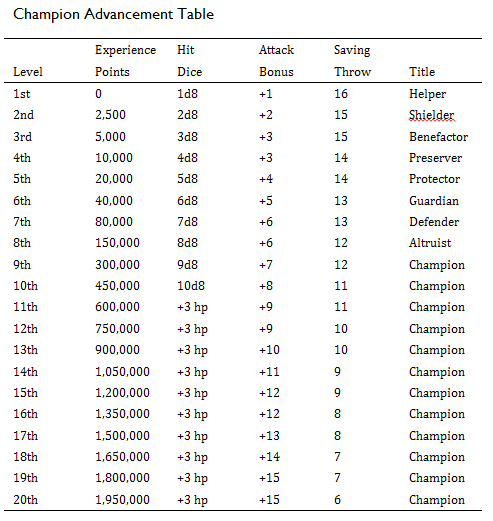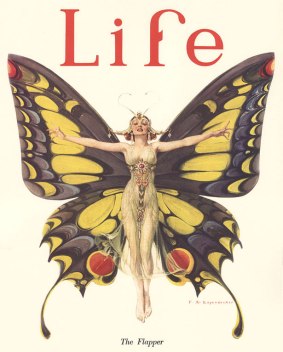 I wind up my little Rainbow Fantasy series of tributes to children’s TV fantasy action shows with a class based on probably the two best such shows, He-Man and the Masters of the Universe and She-Ra, Princess of Power.
I wind up my little Rainbow Fantasy series of tributes to children’s TV fantasy action shows with a class based on probably the two best such shows, He-Man and the Masters of the Universe and She-Ra, Princess of Power.
The Champion
Champions are warriors that draw their power from an oath to defend a Lawful place, institution or divine entity. They often appear as shining knights, and preach a philosophy of mercy, honesty and generosity. Although implacable foes of Chaos, they are not killing machines; a champion would prefer to subdue evil or convert it to goodness if possible, rather than simply slay it.
Requirements & Restrictions
To be a champion, a character must have the following minimum scores: Str 9, Wis 11 and Cha 13.
Champions must be Lawful in alignment. They can use all armors, shields and weapons.
A champion who ceases to be Lawful or whom grossly violates the champion’s code of conduct (see below), loses all special abilities, including the services of their mount (see below). The fallen champion may not progress any further in levels as a champion until she atones by gaining enough experience to gain another level without the use of her special abilities and while acting in perfect accordance with his alignment and code of conduct.
Champion Skills
Champions add their level to the following task checks:
Healing—Champions are knowledgeable about applying bandages, mending broken bones and compounding medicines, unguents and tinctures. They can stop wounds from bleeding, and with a successful check grant a +1 bonus to save vs. ongoing poison and disease.
Riding—Champions are capable of fighting while mounted at no penalty, and can use this task for dangerous (and awesome) stunts.
Champion Abilities
A champion must take a sacred oath to a Lawful cause or entity. Her sword (or other weapon) becomes a symbol of this oath. If a champion comes into the possession of a better weapon, she may transfer her oath to it.
A champion is immune to disease, and can cure disease once per week per 5 levels attained. Her touch can calm emotions (as the spell) three times per day. Comrades adventuring with a champion receive a +2 bonus to save vs. mind-affecting effects.
A 2nd level champion can heal wounds (her own or those of others) by touch. This is called the “laying on of hands”. Each day she can heal a total number of hit points of damage equal to twice her champion level. She may choose to divide her healing among multiple recipients and she does not have to use it all at once.
A 3rd level champion gains the ability to amplify her heroic powers once per day by invoking her sacred oath while holding aloft the weapon on which she took her oath. This exact form of this amplification can be chosen by the champion. To simulate this, the champion receives a number of Power Points equal to her level divided by two (rounding up) per day. One power point can be spent to gain a +1 bonus to attack or save or a +2 bonus to Armor Class or damage or a +10′ increase to speed. These power-ups last for 10 minutes. Three power points can be spent on an augury, strength or haste spell effect with duration as the spell’s in question.
A 4th level champion can undertake a quest guided by a divine vision to find and gain the service of an unusually intelligent, strong, and loyal mount to serve her in her crusade against evil. This champion can choose from one of the following mounts: Celestial warhorse, pegasus, spotted lion, tiger or unicorn (female champions only). Treasure Keepers can add other animals to this list as they wish.
 The mount and its location appear in a vision. The location is no more than a week’s ride away, and the challenge involved in claiming it should be difficult but not impossible.
The mount and its location appear in a vision. The location is no more than a week’s ride away, and the challenge involved in claiming it should be difficult but not impossible.
For every three levels the champion gains after 4th level, her mount gains one Hit Dice.
A champion wielding a weapon sword can deflect rays, beams and magic missiles a number of times per round equal to half their level (rounding down). Instead of automatically deflecting a ray, the champion can try to aim the deflection. To do this, the champion must roll 1d20 under her dexterity score; if the save is successful, her target must pass a saving throw or be struck by the ray, beam or magic missile. This ability does not work against lightning bolts or fireballs. A 3rd level champion can also choose to convert the ranged attack into a color spray spell. A 6th level champion can convert the ranged attack into a rainbow pattern. A 9th level champion can convert the ranged attack into a prismatic spray.
Swearing Fealty
A 9th level champion can swear fealty to a Lawful outsider, becoming their agent and champion on the Material Plane. The champion is charged to defend a Lawful realm under the protection of the outsider in question. To aid her on her quest, the champion gains the services of 1d4+2 followers. Roll on the following table to discover what sort of followers the champion attracts:
Roll d%
01-08 Automatons (1d6)
09-12 Crystal men (1d3)
13-20 Dwarves (1d6)
21-28 Elves (1d6)
29-36 Gnomes (1d6)
37-44 Hawk men (1d6)
45-64 Men-at-arms (1d6)
65-70 Nixies (1d4)
71-74 Pixies (1d3)
75-76 Shambling mound (1)
77-78 Bard (level 1d6+1)
79-80 Butterfly (level 1d6+1)*
81-82 Duelist (level 1d6+1)
83-86 Fighter (level 1d4+1)
87-90 Magic-user (level 1d4+1)
91-92 Monk (1d4+1)
93-96 Scout (level 1d6+1)
97-00 Sorcerer (level 1d4+1)
* See THIS POST for the butterfly class
Strongholds
A 12th level champion may conquer an evil stronghold and sanctify it for her own use or simply construct a stronghold of her own. The stronghold must be a symbol of goodness for all the land, not just a mere construction of stone and metal. When a champion occupies a stronghold, she adds 1d4+2 more followers to her retinue, plus 60 Lawful men-at-arms of a type determined by the champion.
Champion Codes
Champions live their lives by a code of virtue, and must also abide the following strictures:
• Must always seek to knock foes unconscious rather than killing them – killing is a last resort.
• May not own more than 10 magic items.
• May not retain more wealth than needed to support herself, her henchmen and to maintain her castle.
• May only employ Lawful henchmen. Champions may adventure with non-Lawful characters, but must make at least a small attempt to reform them, and must, at the end of each adventure, explain how that adventure taught a sound moral lesson.
Besides these rules, champions must abide by a code of conduct that demands honesty, mercy and generosity above all things.

 While rainbow fantasy has warriors and weapons and swordplay, it also avoids killing (except for robots – you can bash them up and not get in trouble) and doesn’t seem to care much about treasure. In other words – it is far removed from the “kill things and take their stuff” genre of fantasy gaming.
While rainbow fantasy has warriors and weapons and swordplay, it also avoids killing (except for robots – you can bash them up and not get in trouble) and doesn’t seem to care much about treasure. In other words – it is far removed from the “kill things and take their stuff” genre of fantasy gaming. There are so many kinds of fantasy to choose from. Old D&D was a mish-mash of everything from King Arthur to Hammer films to Elric (which is why I love it), Warhammer does dark and gothic, there are the oiled up barbarians from 80’s movies, fairy and folk tales, weird fantasy and horror … and also what I would have called in my youth “girly fantasy”.
There are so many kinds of fantasy to choose from. Old D&D was a mish-mash of everything from King Arthur to Hammer films to Elric (which is why I love it), Warhammer does dark and gothic, there are the oiled up barbarians from 80’s movies, fairy and folk tales, weird fantasy and horror … and also what I would have called in my youth “girly fantasy”.